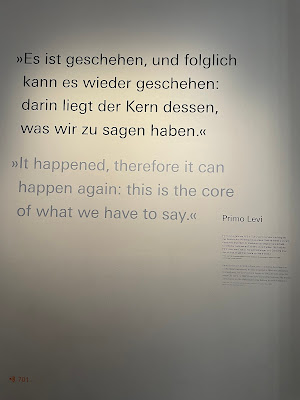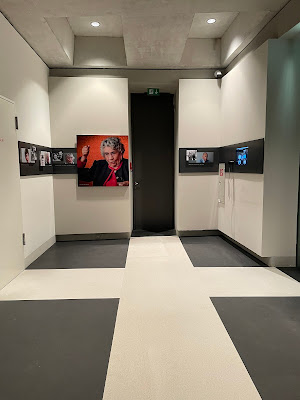Berlin - My morning visit to Tiergarten in Berlin was nothing short of magical. The late morning stroll through this sprawling green landscape. The crisp morning air was invigorating as we strolled along the winding paths, surrounded by lush lawns and towering trees. Birds chirped harmoniously, adding to the serene atmosphere.
 |
| Graffiti on the Tiergarten map |
All around Berlin, graffiti is sprayed on walls and buildings. It was even on the map of this garden. We had our lunch at this garden.
 |
| Picnic in the park |
Tiergarten’s rich history is palpable. Originally a royal hunting ground, the park has evolved into a beloved public space.
The variety of trees and flowers in bloom added vibrant colors to the landscape, making every step a visual delight.
 |
| Sun dial |
Bismarck-Nationadenkmal Statue
Monument complex with a statue of Otto von Bismarck on a high central plinth, flanked by four large bronze figures or bronze groups. The statue of the Chancellor stands on a highly polished red granite plinth, which rests on a three-tiered red granite substructure.
 |
| Bismarck-Nationadenkmal |
Victory Column (Siegessäule)
 |
| Victory Column |
The victory column was built in 1873 to celebrate Prussia's victory in the Franco-German War. It was moved to its present location in the Tiergarten in 1938. We walk up to the top via 270 steps to see great views of Berlin.
The monument survived World War II without much damage. Surrounded by a street circle, the column is also accessible to pedestrians through four tunnels,
The view from the top was fantastic, we had a bird's eye view of Berlin.
Memorial to the Murdered Jews of Europe
The exhibition in the Information Centre documents the persecution and extermination of the Jews of Europe and the historical sites of the crimes. Today's queue was fast and after the bags inspection, the exhibition area was dim down to reflect the sombre atmosphere of this memorial.
Beneath the field of stelae lies an underground information center, which offers a comprehensive history of the Holocaust through photographs, personal stories, and documents. This added a layer of context and poignancy to the visit, grounding the abstract monument in real, heartbreaking human experiences.
Brandanburg Gate
Standing majestically at the end of Unter den Linden, this iconic neoclassical monument, built in the late 18th century, symbolizes peace and unity. Originally commissioned by King Frederick William II of Prussia, the gate has witnessed some of the most significant events in European history, from Napoleon's occupation to the fall of the Berlin Wall.
 |
| Brandanburg Gate |
Approaching the gate, I was struck by its grandeur. The towering columns and the Quadriga, a chariot drawn by four horses driven by Victoria, the Roman goddess of victory, added to its imposing presence.
Official location for EURO 2024.
The Brandenburg Gate is not just an architectural marvel but a historical beacon. It stood as a symbol of division during the Cold War, being located in the no-man's land just behind the Berlin Wall. Today, it stands as a powerful emblem of reunification and peace.
Eastside Gallery - Largest open-air gallery in the world
The East Side Gallery in Berlin stands as a remarkable testament to the power of art and the enduring spirit of freedom. This open-air gallery, which stretches along a 1.3-kilometer section of the Berlin Wall, is not only a canvas for artistic expression but also a poignant reminder of Germany's tumultuous past and its journey towards reunification.
Following the fall of the Berlin Wall in 1989, artists from around the world seized the opportunity to transform this once ominous barrier into a symbol of hope and unity. In 1990, the East Side Gallery was officially inaugurated, showcasing over 100 murals that reflect the elation and optimism of a newly united Berlin.
These works of art capture the emotional and political climate of the time, providing a visual narrative of the city’s transformation.
As you stroll along the East Side Gallery, you'll encounter a diverse array of artworks, each with its own unique message and style. The gallery is also a space for contemporary issues, with recent additions addressing themes such as global peace, human rights, and environmental concerns. This evolving nature of the East Side Gallery ensures that it remains relevant and continues to provoke thought and discussion.
Painted in 1990, it has become one of the best known pieces of Berlin Wall graffiti art. The painting depicts Leonid Brezhnev and Erich Honecker in a socialist fraternal kiss, reproducing a photograph taken in 1979 during the 30th anniversary celebration of the foundation of the German Democratic Republic.
The East Side Gallery has faced challenges over the years, including weathering, vandalism, and urban development pressures. Efforts to preserve and restore the murals have been ongoing, with artists returning to touch up their works and conservationists working to protect this cultural heritage site. These initiatives ensure that future generations can continue to appreciate the gallery’s significance.
Markthalle Neun - Street Food
Markthalle Neun, particularly during their renowned Street Food Thursday event.
Markthalle Neun, a historic market hall dating back to the 19th century, has been revitalized into a modern food paradise. The hall itself is an architectural gem, with its iron framework and expansive layout creating an inviting atmosphere. The market operates throughout the week, but Thursdays are especially magical when the space transforms into a bustling hub of street food vendors from around the globe.
We walked through the crowded street food stalls, vendors were serving many different cuisines from Middle East, Asia and Europe.
Dinner @ Huhnerhaus 36
 |
| Salad with Fried Chicken |
 |
| Rice with Fried Chicken |
The chicken was tender but the skin was so salty. It came with yogurt and the chickpea rice.
 |
| A huge jar of pickle |
 |
| The restaurant mascot |

































No comments:
Post a Comment